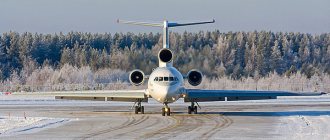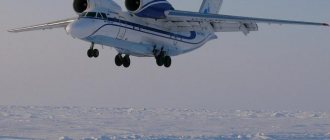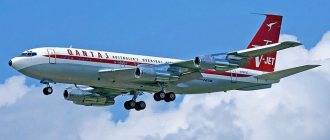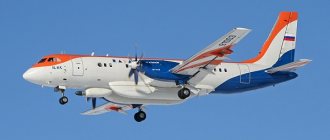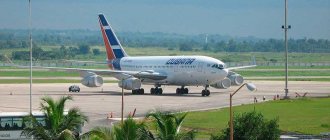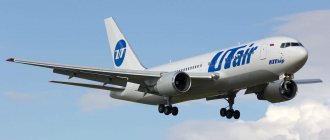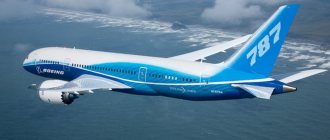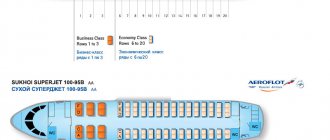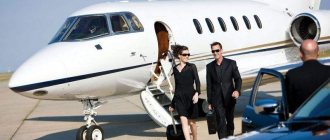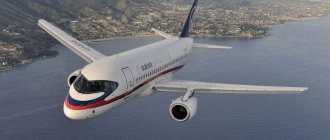The new short-haul aircraft, the Sukhoi Superjet 100 model, was manufactured in the Russian Federation by Sukhoi with the support of foreign companies. This machine is designed specifically for transporting passengers. For this purpose, two modifications were created, which differ in the number of seats for passengers. One device is capable of carrying 75 passengers, and the second – 95. In addition, there are models that are designed for longer flights.
The design of the aircraft for short and medium range flights began in 2000; during its development it was called a regional aircraft for Russia.
Brief chronology of the creation of the Sukhoi Superjet 100 aircraft
In the spring of 2003, a project under the working name RRJ (No. 97 002) won the aircraft design competition. In 2006, we began assembling a prototype of this device. The machine was assembled at KnAAPO, and a year later this project was delivered to the city of Zhukovsky for further testing at the TsAGI bureau. The product was transported to this city using a Ruslan aircraft.
The first prototype of the Sukhoi Superjet 100 aircraft was presented in September 2007. For the first time, this aircraft model lifted off the runway a year after its presentation, namely in May 2008. But before the first flight, the designers spent a lot of time checking all the main systems of the machine.
By the end of 2008, the Sukhoi Superjet 100 aircraft completed factory tests, and the state certification process began with the participation of an international commission. Resource studies of the aircraft took place at the Siberian Research Institute. The second aircraft was completely ready by December 2008; during testing, this aircraft showed excellent flight characteristics.
This device was presented to the general public at the air exhibition in Le Bourget in the summer of 2009. The Sukhoi Superjet 100 model aircraft, fully equipped with all systems and with a fully equipped passenger cabin, made its first flight only in the summer of 2009.
Feedback from pilots and passengers
Pilots and passengers rate the aircraft highly. Pilots like ease of control, speed of climb, obedience both in normal mode and in the so-called. “direct control” mode (Direct mode, when many restrictive automation functions are disabled). Passengers note the comfortable cabin height, the width of the aisle and seats, as well as the uniquely large volume of luggage racks: unlike Canadian and Brazilian regional airlines, when transferring to an SSJ from a B-737 or A-320, there is no need to put hand luggage in a separate trunk. The most comfortable cabin option is installed in the Interjet SSJ-100 - the largest step between the seats plus screens in which you can see the view from the front video camera. Among foreign air travelers, the SSJ is considered a rare type of aircraft; aviation enthusiasts specifically buy Aeroflot tickets to fly to Moscow on it.
For airlines, the SSJ is attractive due to its fuel efficiency. At a flight level of 10,000 m, aircraft have to fly at speeds no lower than those of the A-320 and B-737. For the Superjet, these are optimal speeds; the flight is economical, unlike its competitor from Brazil, for which this speed is too high and leads to excessive fuel consumption.
Aircraft Features
The creation of this aircraft took place in close partnership with foreign aviation companies. The main consultant on the creation of the Superjet was the world-famous Boeing corporation. More than 30 companies were involved in the manufacture of this aircraft, supplying components for the aircraft.
The aircraft is equipped with a high-quality remote control system, which was provided by Liebherr Aerospase. The vehicle's onboard equipment was provided by Thales Corporation. Even all the passenger compartment components were developed and provided by Aerospase. In addition to all this, systems such as the chassis, hydraulic system, fuel system, brakes, and power supply were also provided by foreign companies. All this made it possible to equip the new aircraft with the most modern digital control systems, which helped achieve high results.
The aircraft has a classic low-wing design, which is equipped with two new generation turbojet engines. The tail of the vehicle has a swept-back shape with a single-fin design. The power plant is represented by two SaM146 type engines, which are attached to the pylons of the aircraft’s wings. The remote control system equipped with this aircraft can automatically control the ship. In addition, it is possible to remotely release the chassis and control the braking system. The control system is so high quality and safe that it made it possible to completely remove the mechanical control of the device. Using this system, you can control stabilizers.
For the first time, an aircraft created at the Sukhoi design bureau is equipped with a system that protects the aircraft from touching the runway with its tail during landing or takeoff, even in the event of a pilot error. The on-board system performs a complete analysis of all aircraft systems and notifies pilots of even the slightest malfunction.
As for avionics, there were also innovations and innovations. It is equipped with a triple high-quality UVK communication system. It protects the car from mid-air collisions with other aircraft. The Sukhoi Superjet 100 aircraft is equipped with a system that allows landing with minimal pilot participation and belongs to ICAO category IIIA. As for the uniqueness between other aircraft of the Sukhoi design bureau, it should be noted that the Sukhoi Superjet 100 model aircraft is 95% unique and has almost nothing in common with previous OKB models.
At the beginning of 2015, 88 Sukhoi Superjet type aircraft were manufactured. Among them were 8 prototypes, and 56 of them were transferred to customers.
As for commercial operation, it began in 2011 with the first flight from Yerevan to Moscow. This flight was carried out by an Armenian company that purchased this airliner. Aeroflot also uses it; it has purchased 10 cars. But these cars are supplied at a discount, since Aeroflot supposedly shares the operating risk with the manufacturers. In addition, this Sukhoi Design Bureau vehicle is used in Yakutia, Indonesia, Vietnam, Mexico and other regions of the globe.
In addition to numerous advantages, the Sukhoi Superjet 100 aircraft also has disadvantages. The standard vehicle is designed for a take-off weight of 49.5 tons. But most sales are focused on the model, which seats 95 and has a takeoff weight of 45.9 tons. This model had to be improved and the structure of the machine had to be strengthened, which led to an increase in weight, and as a result, to high fuel consumption during flight.
Despite everything, this aircraft is truly a breakthrough in the domestic aircraft industry and will be able to bring our aviation industry to world markets.
Sukhoi Superjet 100-95 (short certification name for the RRJ aircraft family - SSJ 100, ICAO designation: SU95) is a short-haul Russian passenger aircraft, which was developed jointly with a number of foreign companies.
05/28/2014 At the moment, 5 pre-production, 38 production aircraft and one airframe for static tests and one more for endurance tests have been built.
Exploitation
Armavia
04/19/2011 Armavia, an Armenian airline experiencing financial difficulties, purchased the first production Sukhoi Superjet 100 (tail number EK-95015), and two days later operated its first flight from Yerevan to Moscow. This date marked the beginning of the commercial use of aircraft of this type. The flight arrived at Terminal C of Sheremetyevo Airport at 4:45 Moscow time. More than 90 passengers were on board the aircraft.
In August 2012, Armavia announced the abandonment of the previously purchased Superjet aircraft.
Sukhoi Superjet 100 and MS-21 – Russian Civil Aviation
Aeroflot
The first commercial flight of an aircraft with tail number RA-89001 under the Aeroflot flag took place on June 16, 2011 along the route Terminal D, Sheremetyevo, Moscow (09:10 Moscow time) - Pulkovo, St. Petersburg (10:40 Moscow time) .
To Aeroflot, the supply of aircraft, according to the State Aircraft Establishment, is obviously unprofitable, since aircraft are purchased at a significantly lower price than their catalog value ($23-24 million) due to the fact that Aeroflot, as a large first customer, shares certain risks associated with implementation of the project.
GSS wants to buy the first ten aircraft supplied to the airline (in the “light” configuration) in 2014 at an average price of $19 million. Along with this, instead of the purchased ones, new ones (in the “full” configuration) will be delivered to the aviation company, made taking into account the wishes of the carrier regarding the configuration, which have changed.
Yakutia
On January 23, 2013, the Sukhoi Superjet 100 of Yakutia Airlines made its first passenger flight on the route Khabarovsk - Yakutsk. There were 49 passengers on board.
Photos of the SSJ 100 interior
Sky Aviation
Commercial use of the Sukhoi Superjet 100 (tail number PK-ECL) by Sky Aviation, an Indonesian airline, began on 03/23/2013. The plane flew to Sorong from Makassar.
Lao Central Airlines
On March 24, 2013, the Sukhoi Superjet 100 (tail number RDPL-34195) of the Lao Central aviation company made its first commercial flight on the Luang Prabang-Vientiane route.
Muscovy
The first flight Tivat - Moscow was made on 08/11/2013 on an aircraft originally built for Armavia. From 16.09 the Moscow – Stavropol flight became regular.
Interjet
On September 18, 2013, the aircraft supplied to the Mexican airline made their first commercial flights. The first aircraft, serial number 95023, flew to Torreon from Mexico City. The second plane, serial number 95024, was sent to Aguascalientes from Mexico City.
The best seats in the cabin of the Sukhoi Superjet 100-95B - Aeroflot
Main characteristics of SSJ 100
The maximum passenger capacity is 103 seats (this configuration was ordered by UTair airline). Despite the name "Regional", the Long Range version (SSJ 100 LR) has a flight range of more than 4000 km. For its speed category “C” (cruising speed - 830 km/h, maximum speed - 860 km/h), the aircraft can land on a very short runway - 1700 m. Currently, according to technical parameters, 57% of all 158 airports in Russia are capable of landing this type of aircraft (not all of these 57% passed the appropriate registration).
What are the future prospects for the SSJ100?
Despite the problems of the SSJ on the international market, the Norwegian airline Norwegian Air Shuttle, which is one of the three European low-cost companies (low-cost airlines), entered into a memorandum with the State Air Force on the supply of 40 SSJ100 aircraft with the ability to fly on the Trans-Siberian route, RBC wrote in October.
Sukhoi has agreed to sell 40 Superjet to a low-cost airline from Norway Business
RBC's source in the UAC reported that at the end of September, during the Istanbul Teknofest aviation festival, preliminary agreements were reached on the supply of SSJ100 to Turkey. “The negotiations may not be limited to the supply of aircraft; localization of production is also being discussed,” he said. Earlier, following the results of the MAKS aerospace show, where President Vladimir Putin personally presented a number of Russian civil aircraft to Turkish President Recep Erdogan, the MS-21 and SSJ100 airliners were sent to participate in the exhibition in Turkey. Initially, this was not in the program, RBC’s source in the UAC said.


